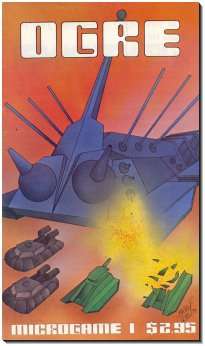Microgame

A microgame (sometimes written "MicroGame") is a board game or wargame packaged in a small set.
Description
Microgames enjoyed popularity during the 1980s. The term generally refers to board games or wargames which were packaged and sold with instructions and maps or playing surfaces printed in a booklet format, or as one large sheet folded until it became "pocket sized" (approximately 4×7 inches). Game pieces (also known as chits or counters) were printed on one or more sheets of thick paper which the player sometimes had to cut for themselves. Other microgames had fully die-cut cardboard sheets like those included with most board wargames.[1] Steve Jackson Games used the Pocket Box to package many of their games in this format.
While small scale wargames and board games, including Tabletop Games' Micro Series Games,[2] had existed before they began publishing, Metagaming Concepts first used the term "MicroGame" when they released Ogre, MicroGame #1 in 1977.[3]
Publishers
Some publishers of microgames include:
- Cheapass Games
- Dark City Games
- "Good Little Games".
- Game Designers' Workshop (defunct)
- "Laboratory".
- Metagaming Concepts (defunct)
- Operational Studies Group
- Simulations Publications, Inc. (defunct)
- Steve Jackson Games
- Task Force Games (defunct)
- "Tasty Minstrel Games".
- Tri Tac Games
- TSR, Inc. (defunct)
Nanogames
Nanogames are smaller (of course) than microgames and often consist of nine or fewer cards, with a few other components.[4]
Notes
- ↑ While the exact definition of "microgame" is not fixed, many games have been so called, and Where Art Thou, Romeo? was the first self-styled "nanogame". Johnson, Mark (October 23, 1999). "Microgame HQ FAQ: What is a microgame?". Microgame HQ.
- ↑ Brown, Peter (September 6, 2014). "Series 2 games - Micro Warfare". life in miniature.
- ↑ Scoleri III, Joseph (March 2, 2002). "The Metagaming MicroGame Games, Page 1". The Maverick's Classic Microgames Museum.
- ↑ http://www.finemessgames.com/nano-games
External links
- "The Maverick's Classic Microgames Museum". by Joseph Scoleri III